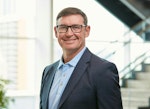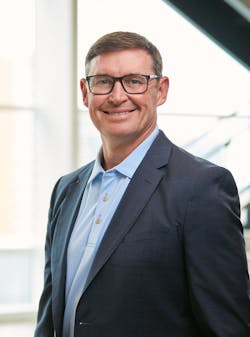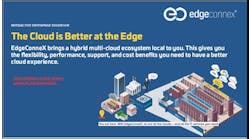We Now Know More About Data Center Sustainability
A note from Stuart
It’s been a big year for sustainability at Stream Data Centers. In February 2023, I wrote an article for this publication, What We (Don’t) Know About Data Center Sustainability, providing an overview of how our approach to sustainability (and, indeed, the industry’s understanding of it) had evolved. “From the pre-PUE days where it was typical for mechanical loads to equal IT loads, to the tradeoffs between energy and water, to the more recent focus on GHG emission reductions, we have learned a lot, and will continue to.”
But, “There’s a lot we don’t know. Still, we must take action to mitigate our environmental impact, and we must work together to do that. At Stream, in alignment with our guiding principles, we’re committed to supporting our customers’ climate action goals, and to working with our partners and even our competitors to advance our understanding of how best to mitigate the environmental impact of the data center across the value chain.”
In the year and a half since I wrote that article, we’ve done so much. We developed a patent-pending liquid cooling design, published our first sustainability report, and built up our team—including by hiring Amanda Abell as Senior Director of Sustainability.
A note from Amanda
Reading What We (Don’t) Know About Data Center Sustainability, I’m reminded of one of my favorite Maya Angelou quotes: “Do your best until you know better. Then when you know better do better.” I am still new to Stream, but from what I have learned so far, continuous learning and improvement are core tenets of our ethos—a willingness to listen to what is important to our stakeholders and take action.
Stream’s ‘all hands on deck’ approach is incredibly refreshing. To already have teams owning their part in sustainability speaks to the level of commitment and the collaborative, team-focused culture of the company. The integration of sustainability principles into all aspects of the business is setting us up well to drive innovation and maximize business value out of this effort. This carries over into our interactions with customers and peers. We are focused on working together to collaborate on solutions and share lessons learned so we can drive the integration of sustainability in the data center industry as a whole. It is such a fun and exciting time.
In this article we’d like to share our journey of the past year and a half, lessons learned, and where we plan to go next as we continue to learn more and do more.
Where we started
Historically, Stream’s sustainability focus centered around PUE and WUE. We did minimal reporting on other sustainability metrics and were just beginning to look at greenhouse gas (GHG) emissions across the data center lifecycle. We had not yet deepened our focus on how sustainability is integrated into the development of the site as a whole and had not yet formalized an approach to sustainability initiatives broadly.
What we’ve done over the last year
Over the last year, we’ve been focused on gathering baseline data, understanding what is important, and engaging with teams so that we can untie around common goals to drive impact. At the outset, we hired Jacobs Engineering to help us formulate our plan and complete our first materiality assessment. The core of our sustainability strategy, the materiality assessment is based on Global Reporting Initiative’s (GRI) four-step materiality assessment methodology and helped us identify the following six key areas of focus for our sustainability program:
- GHG inventory and reduction
- Sustainable building design
- Talent attraction, development, and retention (which incorporates diversity, equity, and inclusion)
- Health and safety
- Cyber and physical security
- Governance and reporting
To address the material topics of GHG emission reduction and sustainable building design, we used our reference design and construction standard to perform our first cradle-to-gate life cycle assessment (LCA) using ISO Standards 14040 and 14044. This initial LCA calculated the embodied carbon in the form of carbon dioxide equivalent emissions generated from the beginning of the building life cycle through the completion of the building construction. Our reference design and construction standard was developed to efficiently use resources, with an emphasis on material management, energy efficiency, and low water use. The LCA analysis provided data on both the quantity of materials used and the embodied carbon of those components which will allow us to drive GHG emission reductions starting at the development stage of a project.
According to the International Energy Association, upfront embodied carbon emissions account for about 24% of a data center’s total GHG emissions, and the use phase accounts for about 76%. To understand the operational use phase of data center emissions, we conducted our first corporate GHG inventory, using actual operational data from 2022, in accordance with the GHG Protocol Corporate Accounting and Reporting Standard. We built on the lessons learned from that inaugural inventory and completed a comprehensive inventory for 2023. Understanding the GHG emissions profile of our business across all stages of development and operations will ensure that we are tackling emission reduction efforts in a strategic way.
Governance and reporting was also identified as a key area of focus in our materiality assessment. As our new Director of Compliance, Caroline Saxon, puts it, “If you don't have documented evidence of the processes and actions you're taking, you can't demonstrate it. And if you can't demonstrate it, it never happened.” To ensure proper governance of our ESG programs, an accountability matrix showing who's responsible for what actions was developed and agreed upon by all leaders in the organization. To ensure accountability, transparency, and shared learning we have regular governance committee meetings where the leaders of each key priority area report on their progress and share challenges and lessons learned.
What we’re looking ahead to
In the coming year we will be focused on the continued evolution of our sustainability program. We will be setting clear goals and establishing key performance indicators to track our progress as well as continuing to refine our reporting process through automation.
In 2024, we conducted a climate risk and opportunity assessment (IFRS-S2, formerly Task Force on Climate-related Financial Disclosures) and developed risks and opportunities matrices for a variety of climate scenarios. For each scenario, we considered the impact on our business and the estimated return on investment (ROI) associated with taking action on any given risk or opportunity. In the coming year, we’ll use this information to prioritize and establish work streams to tackle the highest priority risks and opportunities.
In addition to focusing on internal goals and improvements, we will also continue to work with industry partners and even competitors to collectively advance the sustainability of the data center industry across the value chain. The introduction of PUE in 2007 by The Green Grid was a turning point for energy efficiency in the industry. It's high time that the industry adopt a standard metric for evaluating carbon intensity that would enable benchmarking and accountability. We look forward to continuing to promote these ideas and sustainability in the industry through our participation in industry groups like the iMasons Climate Accord—to move toward standardized sustainability metrics that reflect the evolving understanding of our industry’s impacts.

Stuart Lawrence
Stuart Lawrence is VP of Product Innovation & Sustainability at Stream Data Centers – which builds and operates data centers for the largest and most sophisticated enterprises and hyperscalers – since 1999, celebrating our Silver Anniversary with 90% of our capacity leased to the Fortune 100.

Amanda Abell
Amanda Abell is Senior Director of Sustainability, at Stream Data Centers – which builds and operates data centers for the largest and most sophisticated enterprises and hyperscalers – since 1999, celebrating our Silver Anniversary with 90% of our capacity leased to the Fortune 100.







